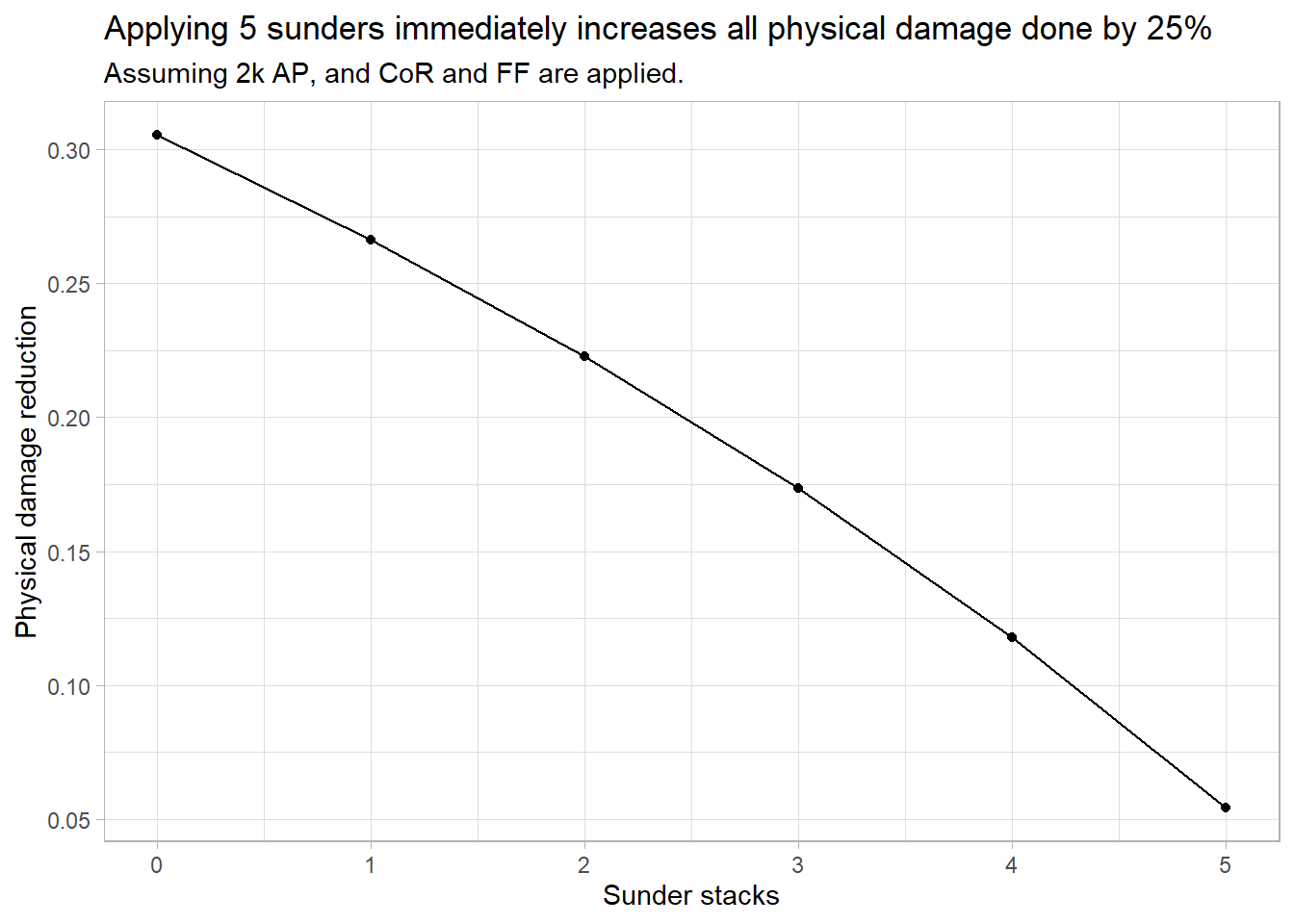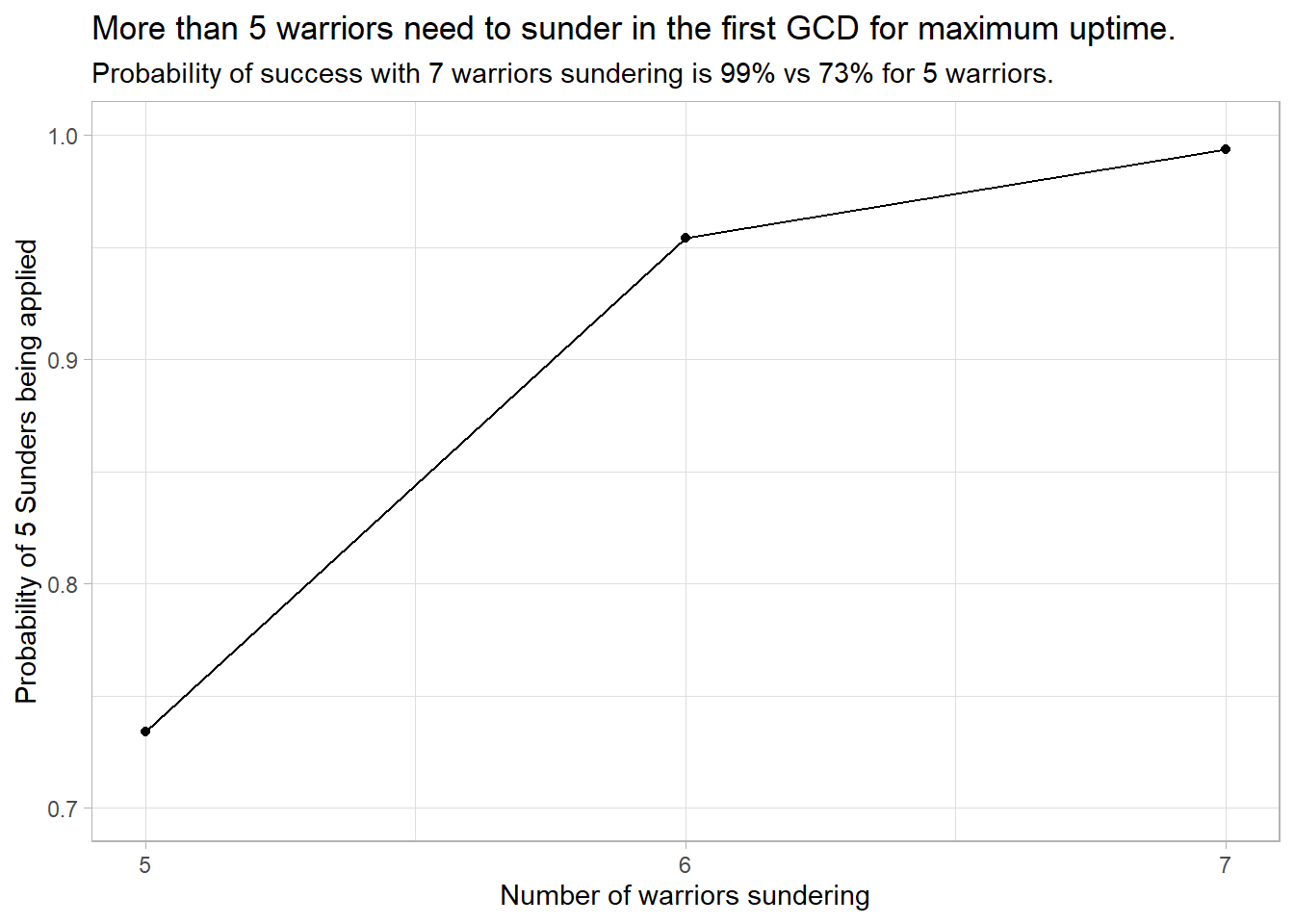Chapter 4 Abilities and Rotation
A warrior’s resource is the finite, yet continuously generated, rage. Rage is capped at 100, and the Vanilla WoW Wiki (Wiki 2019) tells us rage is generated by a successful white attack according to the following formula:
\[\begin{equation} Rage_{gen} = \left(\frac{D}{C}\right) × 15 \tag{4.1} \end{equation}\]Where \(D\) is the damage dealt, and \(C\) is the rage conversion value. The rage conversion value varies by player character level and is dependent on other values such as the mob’s hit points and the warrior’s expected damage value against that mob. It can be calculated by the following formula:
\[\begin{equation} C = (0.0091107836 × Lvl^{2}) + (3.225598133 × Lvl) + 4.2652911 \tag{4.2} \end{equation}\]What this tells us is that very low damage attacks have an upper bound on how much they can be averaged up by the hit factor of the. Knowing this, we can calculate the conversion value for various level ranges:
| Player Level | Conversion Value |
|---|---|
| 10 | 37.4 |
| 20 | 72.4 |
| 30 | 109.3 |
| 40 | 147.9 |
| 50 | 188.3 |
| 60 | 230.6 |
In any given fight, we will only generate a finite amount of rage. This means that to deal as much damage as we can, in the most efficient way possible, we need to maximize the ratio between damage dealt and rage spent - the damage per rage (DPR). This can easily be calculated:
\[\begin{equation} DPR = \frac{Damage}{Rage} \tag{4.3} \end{equation}\]Although this is an easy concept to grasp, it’ll be an essential part of our discussions throughout this chapter from now on. This is because the DPR of our abilities is not constant - Whirlwind’s (WW) DPR varies depending on the number of enemies around and the damage and type of our weapon, Execute’s varies based on how much rage we consume when activating the ability, and Bloodthirst’s depends on our current attack power. Doing as much damage as possible in a fight, thus, is about calculating the DPR of each one of these abilities as the encounter progresses, and utilizing the one with the maximum DPR. We will revisit this concept in more depth in 4.1.
Note: For all of the following damage and DPR calculations, we will assume \(P(Crit)=0.3\), \(P(Dodge)=0.06\), and 305 weapon skill. This hidden multiplier will be applied to all subsequent damage and graph calculations.
4.1 Sunder Armor
Sunder armor (or just Sunder, from now on) reduces the target’s armor by 450 per application, stacking up to 5 for a total armor reduction of 2250. It is an essential toolkit of any warrior, and it is paramount that at least 7 (as we’ll see later) Fury warriors in the raid utilize it in their first global cooldown in order to guaranteee maximum uptime, which will work to massively increase the physical damage done by the raid. First, let’s dive into how physical damage reduction is calculated for level 63 mobs in WoW Classic:
\[\begin{equation} \% reduction = \frac{armor}{armor+5882.5} \tag{4.4} \end{equation}\]We know that most bosses in WoW Classic have 3731 armor. To understand the impact of Sunder, let’s assume Curse of Recklessness (CoR, 640 armor reduction) and Faerie Fire (FF, 505 armor reduction) are also immediately applied. The resulting physical damage increase is shown graphically:

Figure 4.1: Applying 5 stacks of Sunder Armor immediately increases all physical damage done by 25%.

Figure 4.2: Bloodthirst damage is increased by 280 at 5 vs. 0 Sunder Armor stacks.
Not only does sundering in the first global cooldown massively increase physical damage done, it also drastically reduces the chance of ripping threat early from your main tank and possibly dying. It also allows tanks a small window during which they can get ahead (and stay ahead) in threat for the rest of the fight. But sunders, like any other physical attack, is subject to be dodges and parries (and therefore not applied). This begs the question: what is the minimum number of warriors needed to sunder in order for 5 stacks to be applied within the first GCD?
The application of sunder of follows a binomial distribution \(B(n,p)\), where the probability of having \(k\) or more successes in \(n\) independent Bernoulli trials is given by it’s cumulative distribution function:
\[\begin{equation} F(x;p,n) = \sum_{k=0}^{x}{\left( \begin{array}{c} n \\ k \end{array} \right) (p)^{k}(1 - p)^{(n-k)}} \tag{4.5} \end{equation}\]Knowing this, let’s calculate the probability that 5 sunders are successfully applied when 5, 6, and 7 warriors utilize it in their first global cooldown (assuming they attack from behind and have 305 weapon skill):

Figure 4.3: More than 5 warriors need to sunder in the first GCD for maximum uptime.
As we can see, there is an huge 22% difference in the probability of all 5 sunders being immediately applied from just having one extra warrior use it. At 7 warriors, this is virtually guaranteed at \(P(5Stacks)=.99\).